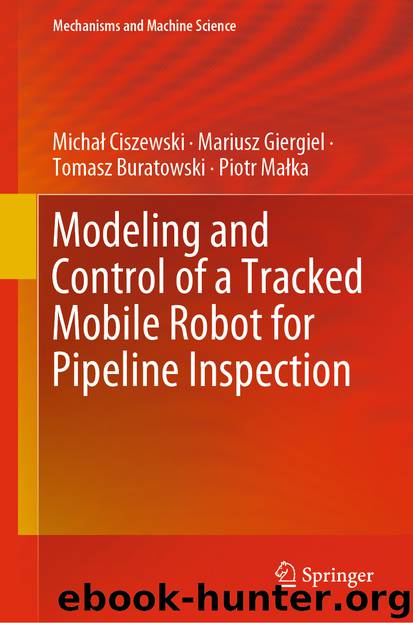Modeling and Control of a Tracked Mobile Robot for Pipeline Inspection by Michał Ciszewski & Mariusz Giergiel & Tomasz Buratowski & Piotr Małka

Author:Michał Ciszewski & Mariusz Giergiel & Tomasz Buratowski & Piotr Małka
Language: eng
Format: epub
ISBN: 9783030427153
Publisher: Springer International Publishing
The results for transformation from neutral poses to horizontal pipes with diameters 210 mm, 242 mm and 300 mm are depicted in Fig. 4.8a–c respectively. Figure 4.8d shows the results for transformation that the robot should perform during motion in pipe connector (reducer) that provides increase of internal diameter from 242 to 300 mm. The transformations depicted in Fig. 4.8a–c are used for initial setting of the robot before working in the pipes. For proper execution in simulation or on a prototype, they require a dedicated stand or a support of the body for unobstructed motion to realize pedipulator trajectories.
The use of 5-th order polynomial interpolation of joint trajectories, utilized in the algorithm, followed by set of calculation steps, gives smooth transition between initial and final poses, as visible in the trajectory plots. The maximum velocity during transformation is limited by angular velocity threshold of servomotors located in robot body and in robot arms. The values are also limited by actual load exerted on the drives by the pedipulator structure. It is visible in Fig. 4.8 that during transformation for motion in horizontal pipes from all the selected initial poses, maximum velocities do not exceed 40 deg/s for 5-s runs that comply with the drives limits. Smooth transformations assured by boundary conditions for the polynomial interpolation of joint trajectories impose also smooth acceleration of all servomechanisms. It should be noted that the transformations are reversible, thus e.g. the trajectory from 242 to 300 mm pipe can be reversed and executed in the opposite sequence.
In Fig. 4.9, pedipulators transformation trajectories for vertical pipes are shown. Three of these trajectories require a dedicated support for the robot body, since they are used during preparation phase before placement of the robot in a vertical pipe (Fig. 4.9a–c). The transformation, depicted in Fig. 4.9d is the most important trajectory for the robot control in vertical pipes. It covers the entire extension range of the pedipulators from 224 to 270 mm diameter pipes. Proper implementation of this transformation trajectory in a control system would provide regulation of clamp force during adaptation to changing dimensions of vertical pipes. Usually, the application scenario in vertical operation would consist of the trajectories, shown in Fig. 4.9a, d for preparation and further adjustment of pedipulators extension.
Fig. 4.9Pedipulator transformations for vertical pipes—drives positions, velocities and accelerations: a from the neutral pose to a 224 mm pipe; b from the neutral pose to a 242 mm pipe; c from the neutral pose to a 270 mm pipe; d from a 224 to a 270 mm pipe
Download
This site does not store any files on its server. We only index and link to content provided by other sites. Please contact the content providers to delete copyright contents if any and email us, we'll remove relevant links or contents immediately.
Algorithms of the Intelligent Web by Haralambos Marmanis;Dmitry Babenko(8529)
Test-Driven Development with Java by Alan Mellor(7438)
Data Augmentation with Python by Duc Haba(7330)
Principles of Data Fabric by Sonia Mezzetta(7076)
Learn Blender Simulations the Right Way by Stephen Pearson(7018)
Microservices with Spring Boot 3 and Spring Cloud by Magnus Larsson(6835)
RPA Solution Architect's Handbook by Sachin Sahgal(6249)
Hadoop in Practice by Alex Holmes(6038)
The Infinite Retina by Robert Scoble Irena Cronin(5952)
Jquery UI in Action : Master the concepts Of Jquery UI: A Step By Step Approach by ANMOL GOYAL(5878)
Big Data Analysis with Python by Ivan Marin(5742)
Life 3.0: Being Human in the Age of Artificial Intelligence by Tegmark Max(5410)
Pretrain Vision and Large Language Models in Python by Emily Webber(4701)
Infrastructure as Code for Beginners by Russ McKendrick(4482)
WordPress Plugin Development Cookbook by Yannick Lefebvre(4213)
Functional Programming in JavaScript by Mantyla Dan(4129)
The Age of Surveillance Capitalism by Shoshana Zuboff(4124)
Embracing Microservices Design by Ovais Mehboob Ahmed Khan Nabil Siddiqui and Timothy Oleson(4004)
Applied Machine Learning for Healthcare and Life Sciences Using AWS by Ujjwal Ratan(3980)
